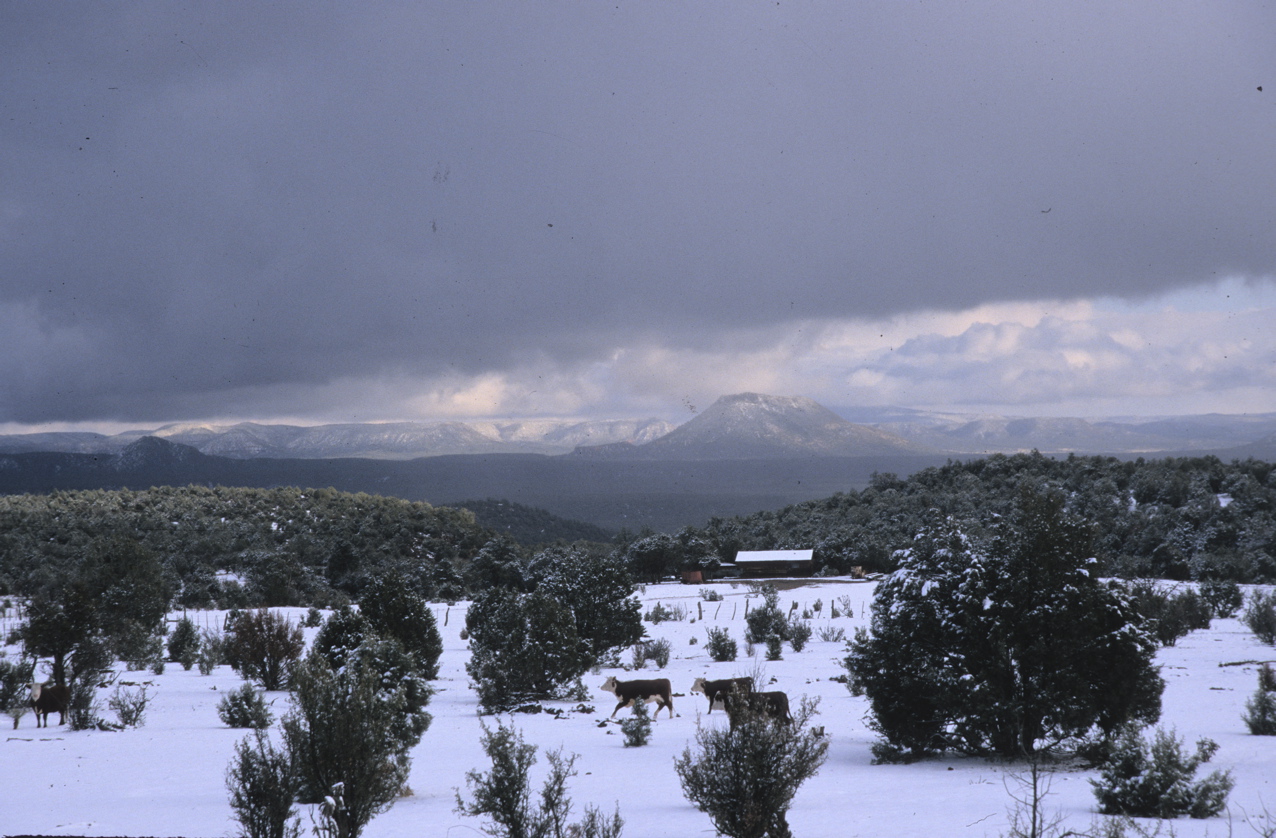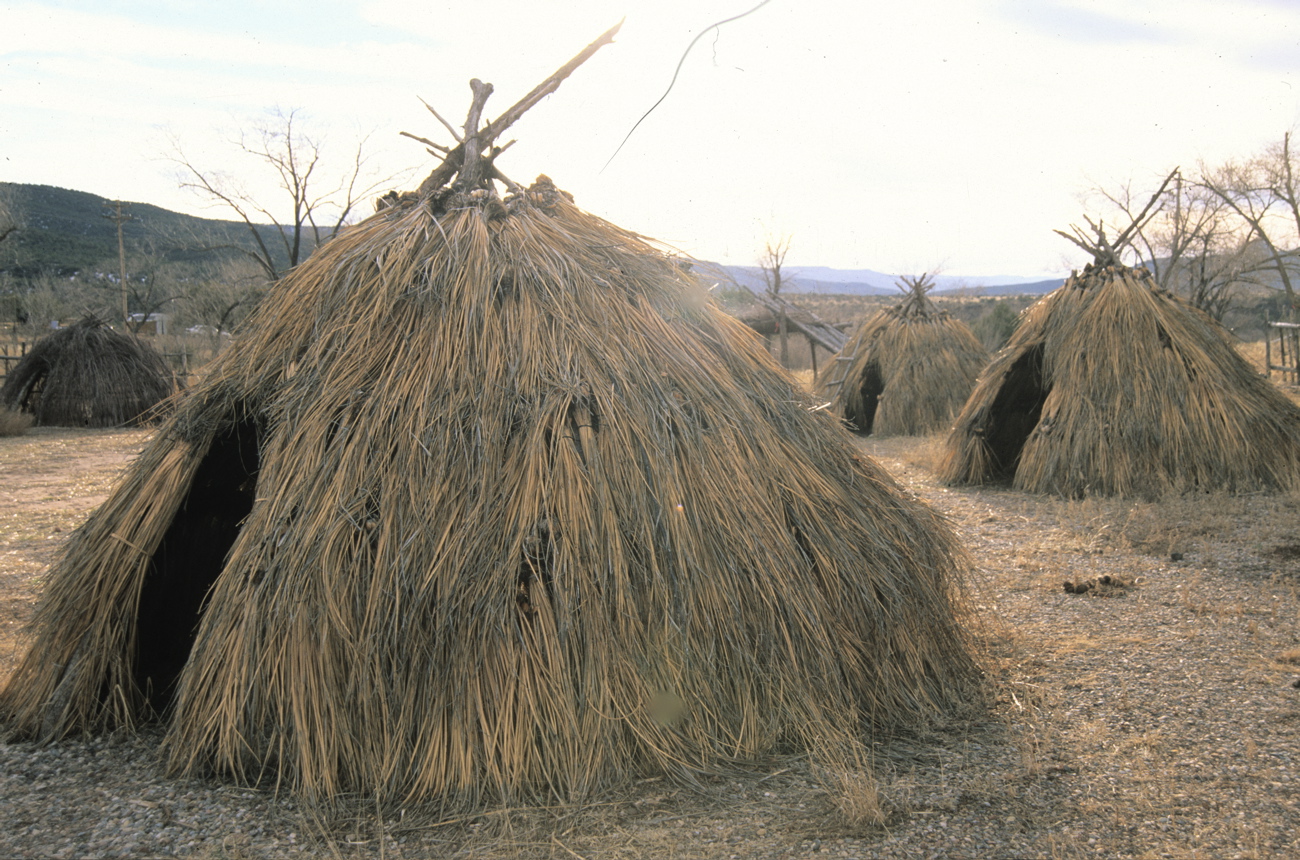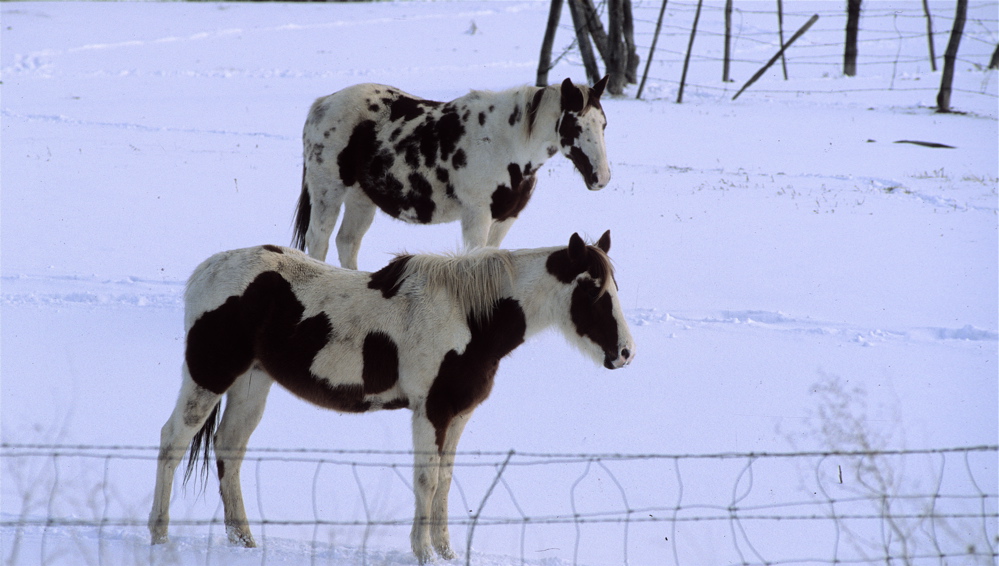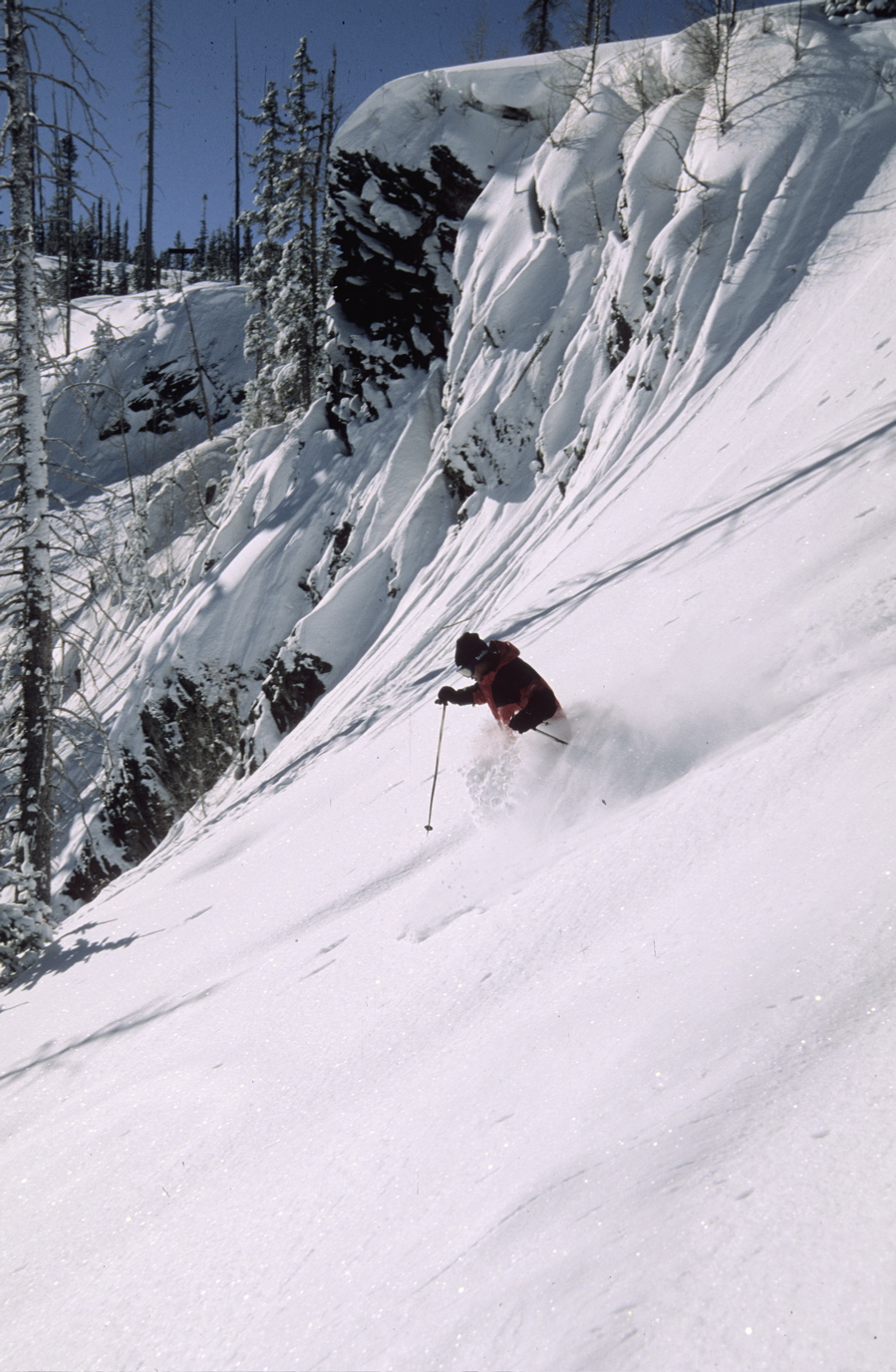Arizona: Apache Sunrise
“Ivan Kasey is a quiet man. Thirty one years old, five foot nine, 180 pounds, with dark eyes and crow wing black hair, his name may allude to a romantic pairing of pale English and White Russian aristocrats”
ivan kasey
"The image of Ivan Kasey skiing deep powder offers
a stark contrast to the Apache’s history."
high mesa, cibecue, arizona
early apache dwellings
The last thing I expected to find in Arizona was deep powder and blue skies. Where are Arizona’s prickly Saguaros? Or its poisonous Gila monsters?
IVAN KASEY loving life
apache lift attendant
“Noting half a dozen kids riding the lift I wonder aloud if Sunrise has
a chance of placing the
first Apache on the
U.S. Ski Team.”
apache trading post barber shop
ivan kasey on patrol
charlene Cheney, sunrise server
“Continuing in a serious voice, he mentions a place of prayer behind Apache Peak and tells me about a cave on the Salt River where the ancients once made offerings of turquoise beads.”
weathered apache saddle
Sunrise Ski Park
www.sunriseskipark.com
Ivan Kasey is a quiet man. Thirty one years old, five foot nine, 180 pounds, with dark eyes and crow wing black hair, his name may allude to a romantic pairing of pale English and White Russian aristocrats but, in truth, Ivan Kasey is a full blooded Apache whose quiet modesty owes much to his father Isaac, one of the first White Mountain Apache’s first Game and Fish Officer, his grandfather Chief Baha Alchesay, and his great grandfather Chief Alchesay One, an Apache Scout who won the U.S. Medal of Honor during the Cochise Wars.
sunrise ski area
It is late January and the combination of an arctic outbreak and a subtropical jet stream has dumped a foot and half of blue smoke powder on Arizona’s Sunrise Park Resort. Standing in the shadow of ancient wolf pines that ring Sunrise’s Cyclone Circle’s I0,700 foot summit, Ivan Kasey pauses to study “Tempest’s” sheer face. Loaded chairs are stalking us up the mountain and a dozen frenzied boarders will soon cut the pristine surface to ribbons but Ivan is in no hurry. On this, his day off from the Sunrise Ski Patrol, he savors the untracked snow then gestures for me to follow.
I watch him reach downhill, plant a pole and fade beneath a cape of incandescent crystals. In rapid succession he unweights and rises to his waist, then sinks into a vortex of flying flakes. His turns are symmetrical, his pole plants precise and perfect and I watch his red jacket float from turn to turn until he disappears over a distant transition.
The image of Ivan Kasey skiing deep powder offers a stark contrast to the Apache’s history. Though Ivan’s ancestors once claimed 60,000,000 acres across what is now Arizona, New Mexico and Mexico, in the three centuries since the Tribes first made contact with the Spanish settlers and later the U.S. Army, generations of Apache’s suffered severe privation.
IVAN KASEY, sunrise powder
The Apache’s called the soldiers “Ndah,” which translates to enemy. It did not matter what they called the soldiers. The “Ndah”could not pronounce or make sense of the Apache language and to keep track of the braves, the soldiers gave them English names. If they were lucky, it was Kasey, Endfield, Hughes or Lee. If not it was simply a number. Either way, the soldiers helped strip the Apaches first of their identity and later their land.
The 1861 arrest of and subsequent shooting of the Chiricahua Apache leader Cochise in what later became known as the “Bascom Affair” started a decade long conflict known as the Cochise War. The first confrontation between the White Mountain Apaches and the U.S. Army, occurred in 1869 when Brevet Col. John Green led a small expeditionary force from Fort Thomas to the confluence of the White River’s North and East Forks. Green promptly burned more than 100 acres of the Apache’s corn. Planted with stone age tools, the blackened corn represented their winter food supply. Green’s act should have sparked a battle. When the braves refused to fight, Green decided that the Apache’s abundant timber, game and farm land needed protecting from white loggers and settlers and established a permanent camp.
On May 16, 1870 what would become Fort Apache was built by the First Cavalry near the town of Whiteriver. While the fort was under construction, the soldiers were dispatched to arrest a Medicine Man named “Noch-Ay-del-Klinne.” Settlers had accused the Medicine Man of stirring up the tribes and in the ensuing Battle of Cibecue, “Noch-Ay-del-Klinne, ” a number of his followers and eight troopers were killed. Weeks later, mounted braves were driven off when they attacked Fort Apache in retaliation. The war ended when Geronimo and the Chiricahua Apaches were loaded into boxcars and exiled to Florida. Geronimo was eventually transferred to Fort Sill, Oklahoma where he died in February of 1909 without ever being allowed to return to Arizona.
Now, nearly a century later, I point my tips down “Tempest” explode a bump, unweight, explode another then stop in amazement. The last thing I expected to find in Arizona was deep powder and blue skies. Where are Arizona’s prickly Saguaros? Or its poisonous Gila monsters?
IVAN KASEY waist deep
The truth is skiers rarely think of Arizona and when they do, are convinced it is too far south and thus too warm and too dry to support a ski area. Absent from that impression is the fact that Arizona’s five 11,000 holy peaks rake moisture from the subtropical jet stream and when it does snow, it snows with ferocious intensity.
Located roughly 220 miles northeast of Phoenix on the eastern boundary of the White Mountain Apache Reservation, Sunrise encompasses three mountains–10,700 foot Sunrise Peak, 11,300 foot Apache Peak and the 10,700 Cyclone Circle. It is tempting to lump Arizona’s four ski areas together in a general survey but they are remarkably different. Of Arizona’s five holy mountains, Mt. Williams near Flagstaff is Arizona’s highest peak while Arizona Ski Bowl uses Flagstaff as a base. Rising to the south of Sunrise, Mount Baldy is both Arizona’s second highest peak and holy to White Mountain tribe while Mt. Lemon near Tucson is the United States most southern resort and often struggles for snow.
Owned and run by the White Mountain Apaches, Sunrise is Arizona’s largest ski resort. Serviced by eight lifts, including four fixed grip triples and the Sunrise High Speed Quad that climbs 1400 vertical feet from the base to the top of Sun Rise Peak, the area offers 1500 acres of skiable terrain and 34 runs which are divided between 40% beginner, 40% intermediate and 20% expert.
IVAN KASEY steep and deep
Expert chutes such as “Eclipse” and “Ronnie’s Dream” plummet off Cyclone Circle while Apache Peak’s broad “Young Girl” and “Elkhorn” are favored by intermediates. Snaking from Sunrise’s Summit, “Crown Dancer,” and “Maverick” are typical of the resort’s wide, fir flanked alleys that mix Apache history with perfect fall lines. The truth is Sunrise skis larger than its statistics and on this bright, cold morning Ivan and I explore the knee deep and barely tracked, “Arrowhead” and “Superstition” then catch the gentle “Lodge View” back to the modern base area.
While loading the Sunrise Quad, I listen to Ivan speak Apache to the lift attendant. Framed in low vowels, soft consonants and short pauses, spoken Apache’s ancient rhythms makes me realize that every Western movie I’d watched as a kid got it wrong. Ivan confesses that while the older men and women will answer him in Apache, reservation children and teenagers reply in a pidgin of English and Apache……a cultural erosion he laments.
“Apache is the polite form on the reservation,” he admits. “But the younger generation now relies more on English.”
snowboarder, sunrise
Noting half a dozen kids riding the lift I wonder aloud if Sunrise has a chance of placing the first Apache on the U.S. Ski Team.
Shaking his head, the solidly built ski patrolman replies that the majority school age skiers come from the towns of Springerville, Pinedale and Show Low that border the reservation.
Born, raised and educated in the White Mountains, Ivan remembers learning to ski was an easy choice. If he kept his grades up he could get out of school one afternoon each week. For that reason he is unsure why more Apaches children don’t ski. With roughly 40% unemployment on the White Mountain reservation, even at fifteen dollars per day for lifts, equipment and instruction, expense plays a part. The numbers, however, are slowly increasing.
Sunrise’s Bill London offers to drive me to Fort Apache one afternoon. A quarter Native American, London was raised on the White Mountain Reservation and learned to ski at Sunrise where he later worked for the ski school and ski patrol. During the drive I admit I am surprised by Sunrise’s snow.
London tells me that though Sunrise suffered consecutive droughts in 1999 and 2000, during a normal season the resort’s 11,000 foot peaks will capture 350 inches and will hold snow well into April. Making the turn into Fort Apache he says Sunrise is typical of most ski resorts. “When skiers switch to golf, tennis and mountain biking, the lack of numbers, not the lack of snow forces the mountain to close.” he says.
Located on a defensible promintory near the town of Whiteriver, with over twenty buildings dating from 1870 to the 1930’s positioned across the 288 acre site Fort Apache’s school, military cemetery, restored Apache Village, and the Apache Cultural Center and Museum offers a powerful insight into Apache history.
London introduces me to Ramon Riley the Apache’s Cultural Resource Director. A powerfully built man in his mid fifties, Riley is responsible for the preservation of Apache oral histories, archival materials and objects of cultural, historical and artistic significance. Surrounded by the Cultural Center’s haunting photos and artifacts, Ramon relates how, as part of a young brave’s conditioning, they would fill their mouths with water then run to the top of a high mountain. Hours later and well after dark, they would return to camp without drinking a drop.
The son of Mary Riley, the first woman to sit on the Reservations Tribal Council, Riley is an accomplished musician whose “White Mountain Apache” tape of traditional songs reveal a man in the process of reconnecting with his heritage. Flipping through a binder filled with photographs of artifacts now owned by New York museums, Riley relates how some were purchased from starving Apaches for a can of soup while others were simply stolen. Using the Native American Graves Protection and Repatriation Act passed in 1990 , he is working to have the intricately woven baskets, ceremonial dresses and hundreds of other artifacts and human remains returned to the White Mountains.
Among the most valuable are the war shirts and shields of long dead braves. Ramon explains that the pieces are far too powerful to return to the reservation. “Bringing them back would only cause trouble.” he says shaking his head.
Besides Sunrise, the White Mountain Tribe generates income from timber harvests and the sale of trophy Elk hunting permits. The biggest money maker by far, is the Hon-Dah Casino. Translated to “Welcome” in Apache, the Hon-Dah runs slot machines and games of draw poker. I’ve never been especially lucky at either and that night feed a one armed bandit in a futile attempt to win a 2001 turbo Mitsubishi. Brent Kurth manages the Hon-Dah and tells me the Casino donates a million dollars a year to tribal education and scholarships. It’s just as well I don’t win the Mitsubishi, and dismiss my gaming losses as a worthy donation to higher education.
salt river canyon
On my last day at Sunrise I arrange to meet Ivan on the mountain. As he skates toward me, I realize much has changed since the Apaches followed migrating game out of the snowy peaks into the desert. Named after Russians and Englishmen to whom he bears no relation, Ivan is as proud of his Apache heritage as he is of his wife Bonnie Ann who he met while instructing, and their year old daughter Mikayla Nalyinn or “Young Girl.” While riding the chair, he says he wished he had seen the White Mountains in the 1800s. He speaks of Yolsin, the sole Apache god then describes a series of holy places known only to tribal members. Continuing in a serious voice, he mentions a place of prayer behind Apache Peak and tells me about a cave on the Salt River where the ancients once made offerings of turquoise beads. Holding out his hand, he says, “If you do not come with respect and honesty in your heart, if you reach into the cave to steal the tourquise, a rattle snake will curl around your arm.”
Ivan and I ski the gentle intermediate runs off Apache Peak and the steep faces off Cyclone Circle. And while the snow falls in cold torrents, we take a left into “Arrowhead” off Sunrise Peak. On this gray day “Arrowhead’s” perfect pitch is softened by deep powder and I cut tracks on skier’s left, next to the trees where the snow washes up my knees and over my jacket. And pointing my skis into the next bump, I feel the light crystals wash across my face.
white mountain ponies
No….this is not what I expected from Arizona. Not snakes in caves, or war shirts with power or snow that blows over your head. Not Holy Mountains, or the living history of the three hundred Apache’s who tune skis, load the lifts, groom runs , teach skiing and fire the bright spectrum of Sunrise.





